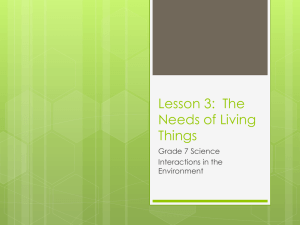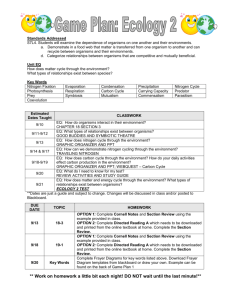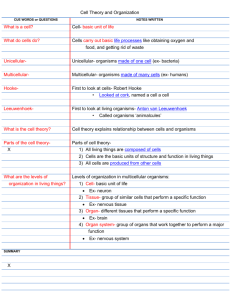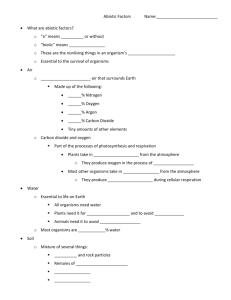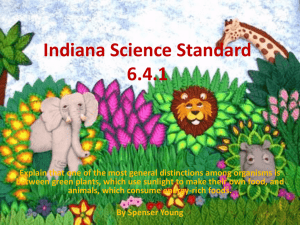Chapter 2- The Ocean Environment!!!!!
advertisement
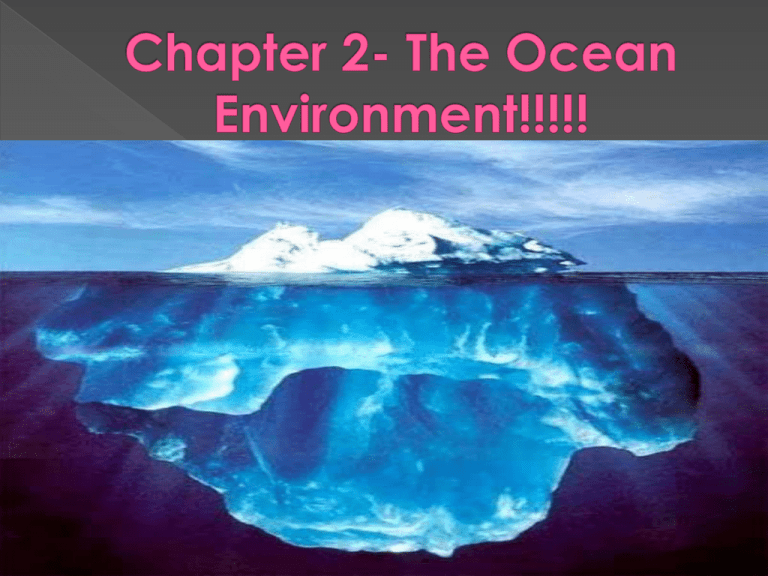
Abiotic-> non-living organisms Biotic-> All living things Ecosystems-> made up of all biotic and abiotic factors Habitat-> specific place where an organism is found Microhabitat-> mini habitats (sand granules) Homeostasis-> maintaining equilibrium / balance Problems: ›Death ›Fail to reproduce Zone of Intolerance * Death *Reprod uction does not occur •Cannot Maintain Homeostasis Stress Zone Expend too much energy and they won’t reproduce Optimal Range All environmental Factors are met. 20-30 C Stress Zone Zones of Intolerance Expend too much energy and they won’t reproduce. Environment is too far gone from the optimal range that the organisms cannot survive. Death Failure to reproduce Can’t maintain homeostasis Sunlight Temperature Salinity Pressure Nutrients Wastes Photosynthesis-> Energy for all life Aids in Vision-> avoid predators, capture prey, and communicate Darkness-> rely on other senses, taste / smell Phytoplankton-> largest photosynthetic organism. › Microscopic, plantlike and bacteria that float in ocean currents. They thrive on sunlight and nutrients so if the water is cloudy they won’t survive. Example-> North Atlantic plankton has to live in the shallows because sunlight can only penetrate about three feet or one meter. South Pacific= 200 meters or 600 feet Excessive sunlight = intense heat= desiccation (drying out) Algae suffers pigment destruction when exposed to too much sunlight which limits their ability to photosynthesize. Obtain body heat from their surroundings Examples-> fish and crabs Regulate body temperature from the inside because of its metabolism (generates heat internally / lots of fat) Examples-> mammals and birds Exposed to high and low tide Drastic changes in temp. from hot days to very cold nights. Organisms have to adapt quickly Fish kills Defined as : The amount of the concentrated dissolved inorganic salts in the water. Most organisms membranes are permeable (things can pass through the skin) Not permeable to everythingselective In order to maintain homeostasis there needs to be a balance between water and solutes When a solute cannot move across the membrane osmosis takes over (H2O goes from areas of high In the open ocean spider crabs cannot regulate the salt concentration of their body fluids because their bodies absorb water and salt. Bays, estuaries, and tide pools are really affected because of evaporation. Water evaporates but the salt remains highly concentrated. Fiddler Crab-> able to adjust the salt content of their body tissues by regulating salt and water retention. Water is denser than air The deeper you go the more pressure you feel Know that the human body is mostly water, and that in recreational diving, water pressure will be felt in the air spaces of the body (lungs, sinuses and ear canals). 10 meters=33 feet=1 atm=14.7 pounds per square inch 3,700 meters= 370 atm = 2.7 tons Build up of nitrogen bubbles in the body- Breathe in 79% Dive-> pressure increases in and around our body->nitrogen becomes absorbed in our body tissues When it reaches saturation that’s when you have a problem because the pressure needs to be released Ascend slowly with frequent “decompression stops” every 10-20 feet. This allows for the built up of nitrogen to slowly exit the body. Not If you do not do this-> nitrogen Do put in notes bubbles build up in the body The bubbles must normally be on the arterial side of the circulatory system to be harmful - they are usually harmless on the venous side. There are many different types. Extreme Fatigue Joint and Limb Pain Tingling Numbness Red Rash on Skin Respiratory Problems Heart Problems Dizziness Blurred Vision Headaches Confusion Unconsciousness Ringing of the Ears Vertigo Stomach Sickness Do Not put in notes Not just food but also organic and inorganic materials. Alone produces nitrogen (no plants=low nitrogen) and phosphorus which phytoplankton and plants need Calcium-> corals, shells, skeletons, and crustaceans By-product o photosynthesis Life evolved in lack of a free oxygen environment so when it entered it was probably harmful (like pollutants and chemicals are to organisms now) Allowed environment that would allow evolution of multicellular organisms Oxygen dissolves at or near surface Waters ability to dissolve oxygen comes from temperature and salinity Cooler/ less salty water= more oxygen Warm / saline water= less oxygen Survive and thrive without oxygen Deep Sea Salt marshes Sand / mud flats Plant, Algae, animals, marine microbes Need oxygen for survival Too many nutrients cause issues such as run-off (eutrophication) which increases nutrient levels -> Explosion= algal blooms or photosynthetic plankton blooms > plankton dies-> bacteria decomposes-> decomposition depletes water of oxygen -> organisms die-> decomposition-> massive die offs Release CO2 Nitrogen rich feces Plants release oxygen Most of the time waste is recycled primarily by bacteria, sometimes levels are toxic A group of the same species Breed with one another 2. Rely on the same resources 3. Deal with the same environmental factors 4. Geographical boundaries where it lives 1. Population= Pod of Killer Whales (J, K, & L) Breed with one another- super pods Same resources-> salmon Deal with same environmental factors-> salinity, temperature, pollutants, etc. Geographic boundaries-> Haro Strait 1. Look at whole area. * Example- hermit crabs in a salt marsh 2. Count the # of individuals in a specific area. * Example- 500 barnacles on a rock or 10 sea anemones in a tidal pool. 3. Aerial Surveys * Ex- Whales and dolphins 4. Sampling Methods-> counting animals in a plot or transect. * Take the individuals per plot multiplied by the total # of plots = population size Captured-> tagged-> released-> wait a sufficient amount of time for the animals to mix back into the population = sample is taken again and the ration of marked: unmarked is documented. Example: Tag 10 nurse sharks-> release-> two weeks later catch 10 more-> and two of the 10 have tags= 20% of the entire population in the area-> population would be 50 sharks because 20% of 50 =10, and 10 is how many were tagged initially. The number of individuals per unit area or volume. Example-> the number of barnacles on a square meter of rock Three types-> Clumped, Uniform, and Random Densely packed in patches May only grow in a certain area Snails clump in areas that are highly populated in algae Ex- oysters, barnacles, schools of fish Evenly spaced out. Result in competition Seaweeds compete for sunlight Ex- Sea stars All over the place Lack of strong interaction among individuals Ex- Conchs, Snails Added via reproduction and immigration Eliminated via death and emigration Each have their own birth and death rate Intermediate ages survive longer (young and old die faster) Generation time-> average time between an individuals birth and the birth of its first offspring. (shorter generation time = higher population) Killer Whales Gestation period equals 16 months! 1000 Type I # Survivors 100 Type II 10 1 Type III .1 Young Old Low death rates with early / middle Higher older death rates Ex- Marine Mammals such as whales Constant Mortality rates over time Ex- Marine birds and crabs (molting) High mortality rates for young Lots of offspring in a short period of time Ex- fish, bivalves, Clutch size # of reproductive events Age at first reproduction Affect the number of offspring a female will have # of offspring produced each time ›Ex-> Sea Turtles # times reproduced Ex-> Pacific Salmon and Octopus reproduce only once and then die. Young age-> less energy for later maintenance Older-> uses up energy for maintenance and could die Invest all of its energy How many of its own offspring survive to produce their own offspring. Phytoplankton species Reproduce in large numbers when environment is favorable Better methods of homeostasis Less affected by environmental changes Recruitment ›1. Reproduction ›2. Immigration (new individuals from other populations joining Phytoplankton have to wait for conditions to be right such as nutrients Carrying capacity is where it levels off= how much the environment can support or hold. What factors determine the carry capacity of an environment? › Density dependent factors › Density independent factors Decrease reproduction Predators- have more to choose from Increase mortality-> decreased food supply Health / survivorship= too many plants in one area will be smaller Stress-> shrinks reproductive organs Size doesn’t matter Weather / Climate Ex-> Hurricanes can wipe out an entire population Communities-> Populations of different species in the same habitat Barnacles Mussels Seaweeds Sea Stars Snails Niche-> “occupation” its role in the environment Mussels- Stick to rocks and filter seawater Crabs- scavenge Worms- burrow in sediment Predator-prey relationships Parasitism Competition for resources Organisms that provide shelter for others Fight / compete for space, food, and mates • Interspecific Intraspecific Between • Between different members of species. a single species No two groups of organisms can use exactly the same resources in exactly the same place at the same time. Local extinction of a less successful competitor= competitive exclusion The #of herbivores are crucial Plants->herbivores-> omnivores/carnivores If there is not enough vegetation herbivores decline because of starvation-> vegetation increases> herbivores increase. Carnivores and their prey (they switch when prey declines) Some predators focus on species that are abundant because they expend less energy -> eats lots of one species They keep the entire ecosystem in check NW Pacific-> Ochre sea star which is a dominant predator that feeds on many organisms but mainly mussels. Ochre Sea Stars were removed for five years-> mussels replenished-> mussels overcrowded the intertidal area-> ochre sea star came back and the sea anemones, chitons, seaweeds, etc. were able to survive again in this habitat. Were hunted to near extinction for their fur. Predominately eat sea urchins and sea urchins annihilate kelp forests and seaweeds. Sea otter population Urchin population Kelp population Sea otters became protected by the MMPA and their population slowly came back and the urchins decreased and kelp increased again. Symbiosis-> relationships between organisms-> “living together” Both organisms benefit Clownfish and sea anemone-> Clownfish has a special mucus all over its body that protects it from anemones stings. Clownfish picks up anemones scent that way the anemone does not eat it. Clownfish gains protection. Anemone gains protection from organisms that might eat it. One benefits and the other is unharmed Remoras and sharks (remora gains protection from the shark as well as eat the leftover food) Barnacles adhering to the skin of a whale or shell of a mollusk: The barnacle benefits by finding a habitat where nutrients are available. Free ride all around the ocean and are exposed to different nutrients. One benefits and the other is harmed. Parasitic tapeworm infects fish and mammals. They live in the intestines and deprive the organism of nutrients. http://www.youtube.com/watch?v=kZCf 9BvK_4o http://www.youtube.com/watch?v=00D XYXVRHkQ http://www.youtube.com/watch?v=gFk diCQxbyg Energy flow through ecosystems Make their own food from sunlight. Examples-> phytoplankton, seaweeds, plants Not all producers are photosynthetic, some are chemosynthetic (use energy from chemical reactions) Ex.-> Bacteria inhabit deep sea vents Rely on others for food. Detritivores-> Feed on dead organic matter Decomposers-> Break down dead organisms Flow of energy from one trophic level to the next. Decrease in available energy from one level to the next. 10% rule= decreases 10% each level cycles of nutrients needed for life Water Equator= supplies the greatest amount of evaporation in all the oceans due to excessive eat and sunlight. Water vapor is carried north and south from the equator and west to east within each hemisphere. When air masses cool and rise = precipitation Sea Salt= precipitation nuclei= sea salt enters the air because of waves crashing. They then collect water droplets and when they get heavy enough they fall back onto the ground as precipitation. Carbon is essential for all living things Backbone of carbohydrates, proteins, lipids, and nucleic acids Living organisms produce carbon when they respire Organism dies Decomposers breakdown tissues (CO2) Marine producers use the CO2 in photosynthesis to make carbohydrates Carbohydrates are used to make other materials CO2 reacts with seawater to form carbonic acid (H2CO3) which forms hydrogen ions and bicarbonate ions Bicarbonate ions are absorbed by marine life and they combine with calcium carbonate (shells and skeletons) The calcium carbonate collects in the sediment and becomes limestone. The limestone appears on land through geological processes where it becomes weathered (wind / rain) -> washes back into the ocean. Producers require nitrogen for protein synthesis, growth, and reproduction Ammonia= NH3, ammonium=NH4, nitrite=NO2, nitrate= NO3 Producers use energy from photosynthesis to concentrate the nitrogen in their tissues and then turn that energy into amino acids-> proteins Nitrogen is then passed in the form of proteins to consumers Proteins and amino acids get processed and released through uric acid, urea, and ammonia Atmosphere= 79% Thunderstorms-> produce nitrates that enter through precipitation Major nitrogen fixing organism in the ocean is cyanobacteria Run-off from land contains nitrogen from fertilizers, sewage, and dead biotic factors= huge growth of phytoplankton Kelp forests, estuaries, salt marshes, mangrove swamps, rocky shores, sandy shores, coral reefs, open ocean Estuary- Receive FW and SW (Tampa Bay) Intertidal Zone- area of shore that is exposed to both high and low tide Water Column Oceans bottom Water overlies the continental shelf Water that covers the deep water basins Sunlight occurs = photosynthesis Largest number of photosynthetic organisms and # animals Darkness= no sunlight penetrates Lowest tide to the edge of the continental shelf Continental shelf to 4,000 meters 4,000 to 6,000 meters deep 6,000 + Organisms that live on the bottom Organisms that live in the bottom sediment. Drift with currents Active swimmers that move against currents Blue mussels are distributed based on the abiotic factors it requires Sea Star’s are found in overlapping areas because of the abundance of mussels Seaweed provides food and shelter Snails are distributed based on where the seaweed and algae is located.

